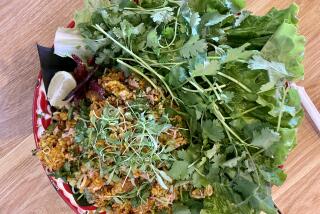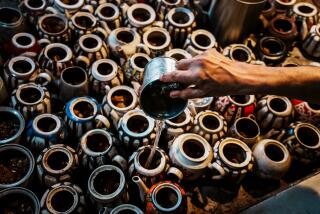How Not to Tenderize Your Steak
- Share via
One of the great old food legends, right up there with the tale of an English king dubbing a particular cut of meat “Sir Loin,” is the one about Mongol horsemen (sometimes Huns) supposedly sticking steaks under their saddles before riding off to war. Thus tenderized, the story goes, the steaks could be cooked quickly, and from this, it continues, descends the dish of raw chopped beef we call steak tartare.
A Berkeley scholar named John Masson Smith notes that there’s no reference to this practice in Chinese historical records, and medieval observers in the Middle East never wrote anything about it either. Smith says there’s a theory that European observers got this idea because central Asian nomads do sometimes put pieces of meat on horses’ backs. But the reason they do it is to lubricate and soothe their mounts’ sores, much as Americans put a piece of beefsteak on a black eye. They don’t eat the “tenderized steaks” afterward.
Traditionally, Turkish nomads such as the Huns and Tatars didn’t even eat steak as such. They would cut meat in small pieces for shish kebab or mince it fine for frying, or they’d boil it, so the toughness issue scarcely arose. As for the Mongols, they cooked nearly everything by boiling.
Medieval central Asian nomads did have special foods for journeys, such as rock-hard dried yogurt (qurut) and boghirsaq, a sort of non-sweet cookie made of flour and lamb fat. In other words, rich, concentrated foods that keep well and need no cooking, like the Native American pemmican or the modern trail mix. They also carried jerky, just the way we do, except that it was usually mutton, not beef.
Actually, bifteck a la tartare is just a fanciful name invented in restaurants. If you’re skeptical about this, just note the two other names for steak tartare, bifteck a la cannibale and bifteck a l’americaine, both of which also suggest exotic primitivism to the French.
More to Read
Sign up for The Wild
We’ll help you find the best places to hike, bike and run, as well as the perfect silent spots for meditation and yoga.
You may occasionally receive promotional content from the Los Angeles Times.






